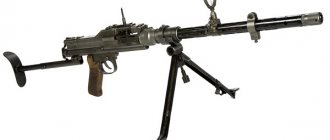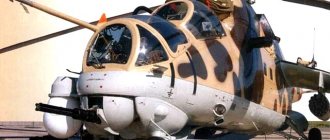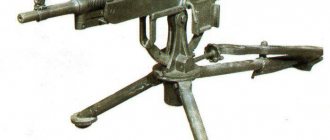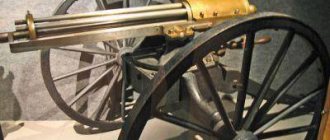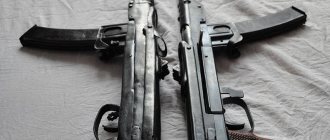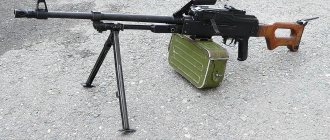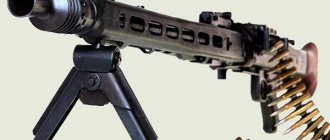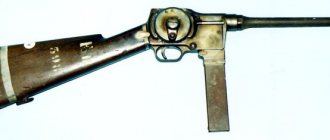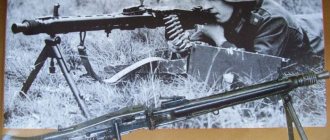| Berezina universal machine gun | |
UBT | |
| Type: | aircraft machine gun |
| A country: | USSR USSR |
| Service history | |
| Years of operation: | April 22, 1941 |
| Wars and conflicts: | The Great Patriotic War |
| Production history | |
| Constructor: | Berezin, Mikhail Evgenievich |
| Designed by: | 1938 |
| Manufacturer: | Izhevsk Machine-Building Plant Tula Arms Plant |
| Options: | UBS, UBC, UBT |
| Characteristics | |
| Weight, kg: | 21.45 kg (UBS) 21.14 (UBK) 21.43 (UBT) |
| Length, mm: | 1390 mm[1] |
| Cartridge: | 12.7×108 mm |
| Caliber, mm: | 12.7 mm |
| Work principles: | removal of powder gases |
| Rate of fire, rounds/min: | 700—800 (UBS) 800—1050 (UBK, UBT) |
| Initial bullet speed, m/s: | 840—860 |
Universal machine gun BerezinaUniversal machine gun Berezina The request “BS (machine gun)” is redirected here. A separate article is needed on this topic.
| External images | |
| [www.ugv.su/oruzsije/strelkovoe/image/ub_2.jpg Photo of UB options. From top to bottom: UBT, UBC, UBS] | |
UB
(abbr.
U
universal
B
erezina
) - 12.7-mm aviation machine gun by gunsmith M. E. Berezin. Produced at the Tula Arms and Izhevsk Machine-Building Plants in the 1940s. Total production: in 1941 - 6300, in 1943 - 43690, in 1944 - 38340, in 1945 - 42952 pieces.
History of creation
In 1937-1938 Berezin designed a synchronized machine gun chambered for 12.7x108 mm, which passed factory and field tests at the end of 1938. On April 12, 1939 (before the end of military tests), the BS machine gun (Berezin Synchronous) was put into mass production by decree of the Defense Committee[2].
After refinement and elimination of certain shortcomings (imperfection of the reloading system, insufficient survivability of some automatic parts), the UB machine gun was developed on the basis of the BS in three modifications: wing-mounted, synchronous and turret-mounted, and for the first two a pneumatic reloading system was created, and for the latter by designer G. I. Nikitin - lever-type reloading handle.[3] The UB successfully passed military tests during the period from January 7 to February 22, 1941, and on April 22, 1941 it was put into service[2] and into production[4].
UB machine gun design
The machine gun has a fixed barrel, assembled connected to the receiver using a locking insert. In the longitudinal channel of the receiver there are moving parts - the bolt and the slide. The slider is connected to the rod using a connector; there is a piston at the front end of the rod. A return spring is put on the rod, which at one end rests against the rod casing and at the other against the piston. On the box there is a body of the impact-break mechanism, held on one side by a semi-cylindrical protrusion, on the other side by an axis that connects the box with the impact-break mechanism and the lid.
source: https://www.airwar.ru/weapon/guns/ub.html
On the right side of the box is a receiver held in place by spikes and a latch. The trigger mechanism is placed on top of the box. At the back of the box there is a buttplate with a buffer and a buffer spring. The buttplate contains the release lever of the trigger mechanism.
Automatic firing of a machine gun is achieved using the energy of powder gases, which are discharged through a transverse hole in the barrel. Powder gases following the bullet along the bore enter the gas chamber and, acting on the piston, force it to move back along with the rod and slide.
When the parts move backwards, the following happens: at the first moment of movement of the slide, a part of the free stroke is selected, and then the bolt is unlocked and the free stroke is finally selected, and the mainspring of the impact-break mechanism begins to be cocked. At the same time, the slider, using a diamond, moves the feed slider from left to right.
After the final selection of the free stroke, the slider begins to advance the bolt using the leg. The bolt connector, running its rounded lower part onto the inclined plane of the box liner, rotates and rigidly connects the slide and the bolt.
At the moment the shutter begins to move, the spent cartridge case is extracted. After the final selection of the free stroke, the slider begins to advance the bolt using the leg. The bolt connector, running its rounded lower part onto the inclined plane of the box liner, rotates and rigidly connects the slide and the bolt.
source: https://www.airwar.ru/weapon/guns/ub.html
At the moment the shutter begins to move, the cartridge case is extracted. The next cartridge is removed from the belt by the bolt's claws, and with the help of a feed ridge it is placed along the axis of the bore, reflecting the spent cartridge case. When the parts move backward, the return spring is compressed. Having reached the rearmost position, the bolt and the slide, rigidly connected to each other by a connector, hit the buffers, compressing the buffer spring.
The moving parts, under the action of the return and buffer springs, move forward and send the next cartridge located in the bolt legs into the chamber. In this case, the next cartridge is moved by the feed fingers in the machine gun receiver.
After the bolt stops on the hem of the barrel, the bolt is locked with a wedge and the slide is free to move, at the same time the next cartridge is fed into the bolt legs with the feed fingers.
In a synchronized machine gun, the tear-off mechanism of the impact-break mechanism works idle before the free movement of the slide, since the tear-off tooth has no engagement with the tooth of the synchronous sear.
At the end of the slide's stroke, the breaker is turned on, and the machine gun is ready to fire. The shot occurs after the mainspring is lowered by the drive from the motor synchronizer.
Under the action of the mainspring, the firing pin, moving forward, strikes the barrel of the box, the barrel of the box transmits the blow to the striker through the bolt blade; the latter, moving forward, breaks the capsule.
In the wing and turret machine guns, the slider, having reached the extreme forward position, turns the automatic release lever, which with its shoulder pushes the detacher body, and with it the synchronous sear. As a result of this, the cocking lever is disengaged from the sear, the mainspring is lowered and the primer is broken (shot).
In order to make a wing-mounted synchronized machine gun, it is necessary to remove the breakaway lever and the lever axis, replace the breaker with a modified breaker and install an automatic release lever.
In order to make a wing machine gun turret, it is necessary to remove the pneumatic reloading cylinder, the hook engine, the hook, the pin and install the rod, reloading handle and control handles.
Options
- UBS
- synchronous, for firing through the plane of rotation of the propeller. Used on aircraft: I-15, I-153BS, I-16 type 29, Yak-1b, Yak-3, Yak-7b, Yak-9, MiG-3 and LaGG-3. - UBK
- wing. Used on aircraft: Pe-2, MiG-3 (suspended in special containers under the wing), UTI MiG-15. - UBT
is a turret modification intended for installation in defensive firing points.
It differed in that instead of a pneumatic one, mechanical reloading was used (a lever-type reloading handle was developed for it by designer G.I. Nikitin). Used on aircraft: Pe-2, Er-2, Il-2, Tu-2, Il-4, Pe-8, A-20 HavocK: Wikipedia: Articles without sources (type: not specified)[ source not specified 2053 days
].
The Berezina universal machine gun celebrates its anniversary
On April 13, 1939, exactly 75 years ago, the BS synchronous machine gun designed by M.E. Berezin was adopted by the Red Army by a resolution of the Defense Committee. The designer began designing a powerful 12.7 mm synchronous aircraft machine gun back in 1937. The machine gun was originally created for a powerful cartridge from a 12.7 mm infantry machine gun. In October-December 1938, the BS machine gun underwent a series of factory and field tests. On April 13, 1939, even before the completion of military tests of the machine gun, on the basis of a resolution of the Defense Committee, it was put into mass production. The 12.7 mm aircraft machine gun was created to combat enemy aircraft - fighters and bombers. This was its main purpose. The machine gun belonged to automatic weapon systems, the operation of which is based on the principle of removal of powder gases through a special hole in the barrel of the machine gun. The barrel bore is locked when fired using a special wedge, unlike the ShVAK and ShKAS machine guns, in which it was carried out by skewing the bolt. The Berezin machine gun was equipped with a striker-type mechanism, which was driven by a special mainspring.
The existing trigger mechanism provided only continuous firing; the machine gun's sear was equipped with a buffer. The BS cartridges were fed using a metal link tape; the tape feeding mechanism was of a slider type. In this case, the supply of cartridges from the receiver to the chamber was not direct. A spring-type return mechanism was placed under the barrel of the machine gun, which was connected to the bolt frame using a special insert. Extraction of the spent cartridge case occurs using the bolt hooks, and its reflection is carried out by the subsequent cartridge in the tape. In the buttplate of the aircraft machine gun there was a special buffer of moving parts. The machine gun barrel was attached to the receiver using a wedge.
Berezin Mikhail Evgenievich
The advantages of this 12.7-mm BS machine gun included: the successful layout of individual mechanisms and the entire machine gun as a whole; simple loading and unloading; high rate of fire; quick barrel change and elimination of delays; a relatively small number of parts and a simple mechanism. The first BS aircraft machine gun was released in October 1938. Tests carried out at the plant demonstrated its good survivability and reliability of its automation. Two other aircraft machine guns, which were assembled in December of the same year, also successfully passed a series of ground tests.
Despite the presence of bright positive qualities, the BS machine gun also had a number of rather serious disadvantages. The main one can be called the difficulties with reloading a machine gun in the air using a cable system, which required great physical effort from the pilot, sometimes at the most decisive and crucial moments of the battle. In addition, defects were identified related to the insufficient survivability of some automation parts, and also required eliminating the cause of some delays in the operation of the machine gun.
Taking all this into account, the gunsmith designer began work on an improved model of his machine gun, which received the designation UB (universal Berezina). The machine gun was created in three different versions, which varied depending on the installation location: synchronous - UBS, wing-mounted - UBK and turret - UBT. At the same time, the main mechanisms and parts of all three machine guns were kept identical, with the exception of the impact and trigger mechanisms, to which some changes were made related to the specific use of this weapon. The UBK and UBS used remote control of the machine gun reloading system in case of delays in firing during flight. Recharging was carried out using compressed air.
UB machine guns
This was the first Soviet aviation machine gun to feature a pneumatic reloading system, which significantly made life easier for the pilot and the operation of the machine gun in combat conditions. Moreover, due to the impossibility of using this system on the turret version of the machine gun (the reason was the dimensions of the cabin), designer G. I. Nikitin designed a new lever-type reloading handle for the UBT.
Military tests of the new version of machine guns took place in 1941, they took place from January 7 to February 22. Synchronized machine guns were tested in the 116th Aviation Fighter Regiment on I-153 and I-16 aircraft. A total of 6 machine guns were tested, from which a total of 48,286 rounds were fired, including 36,870 rounds in the air and another 11,416 rounds in a ground shooting range. In the air, firing from a 12.7-mm machine gun was carried out at altitudes from 1 to 9 thousand meters in bursts of 20-50 shots. Testing the operation of the automatic machine gun in low air temperatures was carried out by shooting at an altitude of about 8-9 thousand meters, where the air temperature reached -42-48 degrees Celsius.
The effect of inertial forces on the operation of the Berezin machine gun was tested by freely firing a cartridge during various aerobatics: on combat turns, deep turns, rolls, loops and during a dive. In all cases, the machine guns installed on the fighters worked reliably, giving a small number of delays. Moreover, when firing, the machine guns, without additional lubrication and cleaning, could fire an average of 1,470 rounds of ammunition, which made it possible to carry out up to 5-6 combat missions per day without removing the machine gun for maintenance.
Installation of the UBS machine gun on the Yak-9T
After the successful completion of the main air test program, the machine guns were subjected to survivability tests in a ground shooting range. The average survivability of machine guns was 10-12 thousand rounds. At the same time, the new machine gun was highly praised by test pilots who shot it in the air. Senior Lieutenant Kryuchkov reported that during military testing, the BS machine gun demonstrated itself to be quite suitable for adoption by the Red Army Air Force. During testing, the machine gun demonstrated uninterrupted operation, with only a few easily removable delays in firing. Therefore, Kryuchkov considered the machine gun’s performance excellent, and other pilots who participated in its tests shared the same opinion. The commission, headed by Hero of the Soviet Union Colonel N.P. Kamanin, noted in its conclusion that the 12.7-mm synchronous machine gun designed by Berezin had passed the tests and could be put into service.
On April 22, the Berezin-designed universal machine gun was officially adopted by the Red Army Air Force. It is worth noting that he arrived just in time, since the war that began 2 months later revealed the ineffectiveness of low-power 7.62 mm machine guns when firing at various air targets. Mass production of UB machine guns was launched at the Izhevsk Machine-Building and Tula Arms Plants.
During the Great Patriotic War, in 1944, Berezin, without any major design changes, was able to easily convert his aircraft machine gun into a 20-mm aircraft gun, which received the designation B-20 and used standard shells from the ShVAK cannon. Also during the war, several attempts were made to use the Berezin machine gun in the ground forces. So, in 1941, I. S. Leshchinsky’s installation was tested, which involved mounting a 12.7-mm Berezin machine gun on a Kolesnikov machine from a DShK machine gun.
UBT machine gun
After the end of the war in the USSR, an attempt was made to modernize the UB machine gun to increase its rate of fire. The task was accomplished by increasing the speed of the leading link. At the same time, the machine gun’s rate of fire increased approximately 1.5 times, but at the same time, the reliability of the machine gun’s automatic operation sharply decreased. As a result of this, the modernized version of the UB machine gun was never put into service.
Berezin UBS synchronous machine guns were installed on many models of Soviet fighters, in particular: I-15, I-153BS, I-16 type 29, Yak-1B, Yak-3, Yak-7b, Yak-9, MiG-3 and LaGG -3.
Wing-mounted Berezin UBK machine guns were mounted on the Pe-2 dive bomber and the UTI MiG-15 training aircraft; they could also be used on the MiG-3 aircraft, suspended on special wing containers.
Berezin UBT turret machine guns were installed on Soviet bombers and attack aircraft SB, Pe-2, Er-2, Il-2, Il-4, Tu-2 and Pe-8.
Tactical and technical characteristics of the UB: Weight: UBS - 21.45 kg, UBK - 21.14 kg, UBT - 21.43 kg. Cartridge used: 12.7x108 mm. Rate of fire: UBK and UBT - 800-1050 rds/min, UBS - 700-800 rds/min. Initial bullet speed: 814-850 m/s.
Sources of information: https://www.vestnik-rm.ru/news-4-7905.htm https://www.23ag.ru/html/ubs.html https://www.xliby.ru/transport_i_aviacija/tehnika_i_vooruzhenie_1998_03 /p2.php https://www.soslugivci-odnopolhane.ru/orugie/5-orugie/93-avia-pulemet.html?start=7
Combat use
Fighter aircraft
| : Incorrect or missing image | This section is missing references to information sources. Information must be verifiable, otherwise it may be questioned and deleted. You may edit this article to include links to authoritative sources. This mark is set May 11, 2011 . |
K: Wikipedia: Articles without sources (type: not specified)
The main purpose is to fight enemy aircraft: fighters and bombers. By the beginning of the war, BS were installed on aircraft such as MiG, I-16 type 29 (only the latter were about 650 at the beginning of the war) [5] and so on. There were complaints in 1941-42 about frequent failures of the machine gun: “...They said that one of our pilots got in the way and wanted to cut him off. But his weapon failed. This was a common defect back then. We had Berezin machine guns and ShVAK cannons. The cannons fired nothing, and the machine guns often failed. They even say there was a big government investigation due to the fact that weapons often failed.”[6]
Strike aircraft
With the outbreak of the war, the UBT quickly replaced the ShKAS from the defensive installations of bombers and was successfully used in them throughout the war. With the advent of two-seat modifications of the IL-2, they also began to use UBT.
Entered service April 22, 1940
On April 22, the Berezin-designed universal machine gun was officially adopted by the Red Army Air Force. It is worth noting that he arrived just in time, since the war that began 2 months later revealed the ineffectiveness of low-power 7.62 mm machine guns when firing at various air targets. Mass production of UB machine guns was launched at the Izhevsk Machine-Building and Tula Arms Plants. In 1941, 6,300 UB machine guns were produced, in 1942 - about 25 thousand, in 1943 - 43,690, in 1944 - 38,340, in 1945 - 42,952. Thus, the total production volume of Berezin machine guns exceeded 150 thousand pieces.
Gunner-sergeant Anashkin Alexander Ivanovich.
The first aircraft originally designed for the installation of a UBS machine gun was the I-200 fighter, the future MiG-3. It is characteristic that the widespread opinion about the weakness of the MiG's weapons is not entirely correct; often rearmed with a pair of wing-mounted UBK machine guns, the "five-point" MiGs had one of the most powerful salvos among all Soviet fighters. Later, synchronized Berezinas became the standard weapon of the LaGG-3, Yak-7, Yak-9 and Yak-3 fighters.
The turret UBT first appeared on the Soviet TB-7 bomber, in which even the Berezin machine guns, which had not yet been adopted for service, were located in original installations in the chassis nacelles, covering the rear lower hemisphere. It is characteristic that on the few TB-7s produced, the composition of weapons in various installations constantly varied, but the pair of UBTs in the “chassis” turrets remained unchanged throughout the war.
During the war, the main consumer of Berezin turret machine guns was the Il-2 attack aircraft. Also interesting is the story of the appearance of the Berezin turret on the Pe-2 dive bomber:
From the memoirs of L.L. Selyakov, deputy director of aircraft plant No. 22, which produced Pe-2 bombers during the war:
“...On the Peshka, the upper defensive rifle installation with the ShKAS machine gun is no good. The Messer comes almost close, it has armored glass, we hit it almost point-blank with the ShKAS. We saw him smiling: Bastards! He rolls to the side, makes a combat turn and calmly shoots you from the upper hemisphere: You need at least a 12.7-caliber Berezin machine gun...
That day I stayed at the plant, gathered the guys P. Chugunov, A. Arkhipov and told them: “Guys, we must install a Berezin machine gun at the top gunner of the Pawn.”
Until that moment, except for Andrei Arkhipov, a master gunsmith, none of us had seriously dealt with weapons. The guys agreed.
We didn’t leave work for 10 days until we made a pilot installation, which could simply be installed on an airplane at the front instead of the old installation for ShKAS. The installation was done. The general view of the “FT” installation was signed by me on February 28, 1942. I had to shoot it at the shooting range. We took the machine gun, ammunition and the installation itself and went to the shooting range. The shooting range was located at the airfield, opposite the assembly shop.
We are greatly weakened. 10 days of titanic labor without decent food, without sleep, were taking their toll. They found some goats at the shooting range and built a setup, which they dubbed “FT” (the front demands it). I loaded the machine gun, not imagining what kind of shooting it would be like. I have never fired a large-caliber machine gun. He spread his legs wider, rested the machine gun on his shoulder and pulled the trigger. What happened next happened completely instantly and according to all the laws of mechanics. I realized that I couldn’t hold the machine gun. I began to fall on my back, frantically grabbing the machine gun and, naturally, squeezing the trigger of the machine gun. Falling on my back with a firing machine gun, I saw tracer bullets describing an arc in the sky. The kit was combat: tracer for control, armor-piercing and incendiary. Instantly I realized: a little more and I would shoot up the assembly shop. Having gathered all my will in the fall, I released the trigger and the machine gun, falling silent, fell on me. Be that as it may, the “FT” installation lived, operated, and that was the main thing, and the fact that I turned out to be a weakling and could not hold the firing machine gun is mere nonsense.
The installation was secured, the required amount of ammunition was fired, and it was put into production.
The first good news arrived from the front, letters of gratitude to the plant and categorical demands for the speedy re-equipment of the entire fleet of combat aircraft. The first combat tests took place on May 5, 1942 near Kerch. tested the 30th Bomber Regiment under the command of Colonel Nikolaev. Their appearance was a complete surprise for the Germans. When our planes returned to base after completing a combat mission, they were intercepted by German fighters. Confident of their impunity, they, as before, coming from the tail, tried to get closer to 300 meters in order to hit for sure.
Several FT installations opened fire almost simultaneously, and 3 fascist fighters, engulfed in flames, crashed to the ground.
Not understanding what happened, the other “Messers” repeated the maneuver routinely and were also shot down.
It was a victory for the new weapon..."
In addition to the above vehicles, turret UBs formed the basis of defensive weapons on the Il-4, Tu-2, Er-2, Ar-2 bombers. An improvised turret was installed on Li-2 transport aircraft. The standard armament on Lend-Lease Bostons and Hurricanes was replaced with Berezin machine guns.
During the Great Patriotic War, in 1944, Berezin, without any major design changes, was able to easily convert his aircraft machine gun into a 20-mm aircraft gun, which received the designation B-20 and used standard shells from the ShVAK cannon. Also during the war, several attempts were made to use the Berezin machine gun in the ground forces. So, in 1941, I. S. Leshchinsky’s installation was tested, which involved mounting a 12.7-mm Berezin machine gun on a Kolesnikov machine from a DShK machine gun.
After the end of the war in the USSR, an attempt was made to modernize the UB machine gun to increase its rate of fire. The task was accomplished by increasing the speed of the leading link. At the same time, the machine gun’s rate of fire increased approximately 1.5 times, but at the same time, the reliability of the machine gun’s automatic operation sharply decreased. As a result of this, the modernized version of the UB machine gun was never put into service, and the time of aircraft machine guns came to an end.
Notes
- [www.iz-article.ru/berzin_ub_1.html IZ-article]
- ↑ 1 2 Shirokorad A. B.
[commi.narod.ru/txt/shirad/140.htm 12.7 mm Berezin machine gun]; Part 1. Machine gun and cannon weapons - Soviet cannon and machine gun weapons // [commi.narod.ru/txt/shirad/ History of aviation weapons]. - Minsk: Harvest, 1999. - 560 p. — 11,000 copies. — ISBN 985-433-695-6. - [bratishka.ru/archiv/2007/7/2007_7_10.php DESIGNERS: SOVIET DESIGNERS OF AIRCRAFT WEAPONS] // Bratishka: Monthly magazine of special forces units. - M.: Vityaz-Bratishka LLC, 2007. - No. 7.
- [vpk-news.ru/articles/6973 Aviation high-temperature // Semyon Fedoseev]
- [base13.glasnet.ru/text/shavrov2/t.htm V. B. Shavrov. History of aircraft designs in the USSR 1938-1950. Table of contents]
- [militera.lib.ru/memo/russian/drabkin_ay3/04.html Military literature - [Memoirs] - Drabkin A. I fought on a fighter. Those who took the first blow. 1941-1942]
An excerpt characterizing the Berezin universal machine gun
- Yes. The doctor looked at the breget. “Take a glass of boiled water and put in une pincee (with his thin fingers he showed what une pincee means) de cremortartari... [a pinch of cremortartari...] “Don’t drink, listen,” the German doctor said to the adjutant, “so that after the third blow there was nothing left.” – What a fresh man he was! - said the adjutant. – And who will this wealth go to? – he added in a whisper. “There will be a okotnik,” the German answered, smiling. Everyone looked back at the door: it creaked, and the second princess, having made the drink shown by Lorren, took it to the sick man. The German doctor approached Lorren. - Maybe it will last until tomorrow morning? - asked the German, speaking bad French. Lorren, pursing his lips, sternly and negatively waved his finger in front of his nose. “Tonight, not later,” he said quietly, with a decent smile of self-satisfaction in the fact that he clearly knew how to understand and express the patient’s situation, and walked away. Meanwhile, Prince Vasily opened the door to the princess’s room. The room was dim; only two lamps were burning in front of the images, and there was a good smell of incense and flowers. The entire room was furnished with small furniture: wardrobes, cupboards, and tables. The white covers of a high down bed could be seen from behind the screens. The dog barked. - Oh, is it you, mon cousin? She stood up and straightened her hair, which had always, even now, been so unusually smooth, as if it had been made from one piece with her head and covered with varnish. - What, did something happen? – she asked. “I’m already so scared.” - Nothing, everything is the same; “I just came to talk to you, Katish, about business,” said the prince, wearily sitting down on the chair from which she had risen. “How did you warm it up, however,” he said, “well, sit here, causons.” [let's talk.] - I was wondering if something had happened? - said the princess and with her unchanged, stone-stern expression on her face, she sat down opposite the prince, preparing to listen. “I wanted to fall asleep, mon cousin, but I can’t.” - Well, what, my dear? - said Prince Vasily, taking the princess’s hand and bending it downwards according to his habit. It was clear that this “well, what” referred to many things that, without naming them, they both understood. The princess, with her incongruously long legs, lean and straight waist, looked directly and dispassionately at the prince with her bulging gray eyes. She shook her head and sighed as she looked at the images. Her gesture could be explained both as an expression of sadness and devotion, and as an expression of fatigue and hope for a quick rest. Prince Vasily explained this gesture as an expression of fatigue. “But for me,” he said, “do you think it’s easier?” Je suis ereinte, comme un cheval de poste; [I'm as tired as a post horse;] but still I need to talk to you, Katish, and very seriously. Prince Vasily fell silent, and his cheeks began to twitch nervously, first on one side, then on the other, giving his face an unpleasant expression that had never appeared on Prince Vasily’s face when he was in the living rooms. His eyes were also not the same as always: sometimes they looked brazenly joking, sometimes they looked around in fear. The princess, holding the dog on her knees with her dry, thin hands, looked carefully into the eyes of Prince Vasily; but it was clear that she would not break the silence with a question, even if she had to remain silent until the morning. “You see, my dear princess and cousin, Katerina Semyonovna,” continued Prince Vasily, apparently not without an internal struggle as he began to continue his speech, “in moments like now, you need to think about everything.” We need to think about the future, about you... I love you all like my children, you know that. The princess looked at him just as dimly and motionlessly. “Finally, we need to think about my family,” Prince Vasily continued, angrily pushing the table away from him and not looking at her, “you know, Katisha, that you, the three Mamontov sisters, and also my wife, we are the only direct heirs of the count.” I know, I know how hard it is for you to talk and think about such things. And it’s not easier for me; but, my friend, I’m in my sixties, I need to be prepared for anything. Do you know that I sent for Pierre, and that the count, directly pointing to his portrait, demanded him to come to him? Prince Vasily looked questioningly at the princess, but could not understand whether she was understanding what he told her, or simply looking at him... “I never cease to pray to God for one thing, mon cousin,” she answered, “that he would have mercy on him and would have let his beautiful soul calmly leave this... “Yes, that’s so,” Prince Vasily continued impatiently, rubbing his bald head and again angrily pulling the table that had been pushed aside, “but finally... finally the thing is, you yourself know that last winter The count wrote a will, according to which he gave all his estate, in addition to the direct heirs and us, to Pierre. “You never know how many wills he wrote!” – the princess said calmly. “But he couldn’t bequeath to Pierre.” Pierre is illegal. “Ma chere,” said Prince Vasily suddenly, pressing the table to himself, perking up and starting to speak quickly, “but what if the letter was written to the sovereign, and the count asks to adopt Pierre?” You see, according to the Count’s merits, his request will be respected... The princess smiled, as people smile who think they know the matter more than those with whom they are talking. “I’ll tell you more,” continued Prince Vasily, grabbing her hand, “the letter was written, although not sent, and the sovereign knew about it.” The only question is whether it is destroyed or not. If not, then how soon will it all be over,” Prince Vasily sighed, making it clear what he meant by the words everything will end, “and the count’s papers will be opened, the will with the letter will be handed over to the sovereign, and his request will probably be respected. Pierre, as a legitimate son, will receive everything. – What about our unit? - asked the princess, smiling ironically, as if anything but this could happen. – Mais, ma pauvre Catiche, c'est clair, comme le jour. [But, my dear Katish, it is clear as day.] He alone is then the rightful heir of everything, and you will not get any of this. You must know, my dear, whether the will and letter were written and whether they were destroyed. And if for some reason they are forgotten, then you must know where they are and find them, because... - That’s all that was missing! – the princess interrupted him, smiling sardonically and without changing the expression of her eyes. - I am a woman; according to you, we are all stupid; but I know so well that an illegitimate son cannot inherit... Un batard, [Illegitimate,] - she added, hoping with this translation to finally show the prince his groundlessness.
